Diabetes is a chronic condition that affects millions worldwide. One of the significant complications associated with diabetes is the development of diabetic foot ulcers (DFUs). These ulcers, though common, can lead to severe complications if not treated promptly. In this article, we delve into the causes, symptoms, treatments, and prevention strategies for diabetic foot ulcers.
1. What is a diabetic foot ulcer?
Diabetic foot ulcer is a skin sore with full-thickness skin loss on the foot due to neuropathic and/or vascular complications in patients with type 1 or type 2 diabetes mellitus.
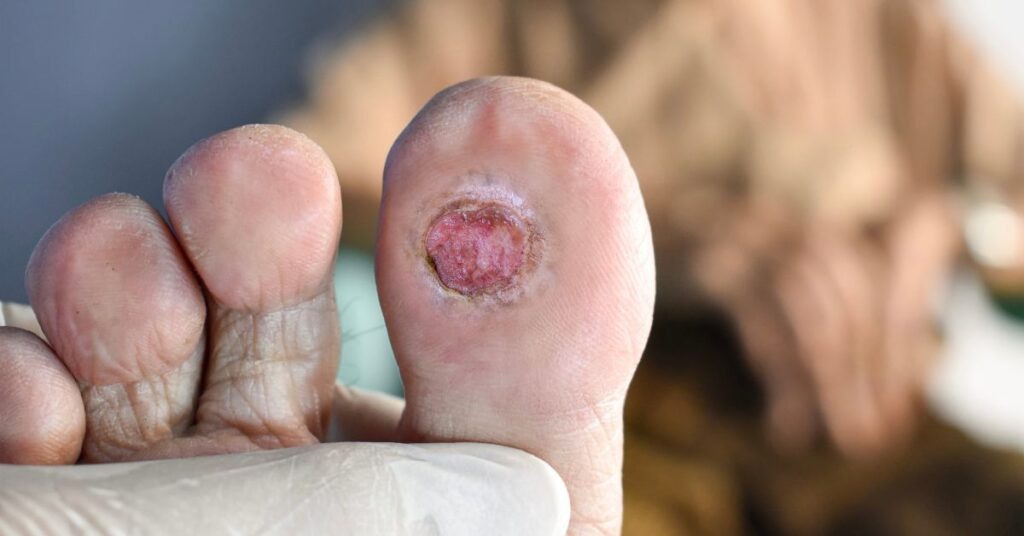
2. Who gets diabetic foot ulcers?
Diabetic foot ulcers are not discriminatory, affecting individuals with diabetes across various demographics. With an annual incidence ranging from 2 to 6%, these ulcers can impact up to 34% of people with diabetes over their lifetime. Certain factors elevate the risk of developing diabetic foot ulcers, including:
Read More: Natural Remedies For Memory Loss in Menopause
- Type 2 diabetes, is more prevalent than type 1.
- A minimum diabetes duration of 10 years.
- Poor diabetic management and elevated hemoglobin A1c levels.
- Male gender.
- Previous instances of diabetic foot ulcers.
- These risk factors highlight the importance of proactive foot care and ongoing monitoring for individuals living with diabetes.
3. Causes of Diabetic Foot Ulcers
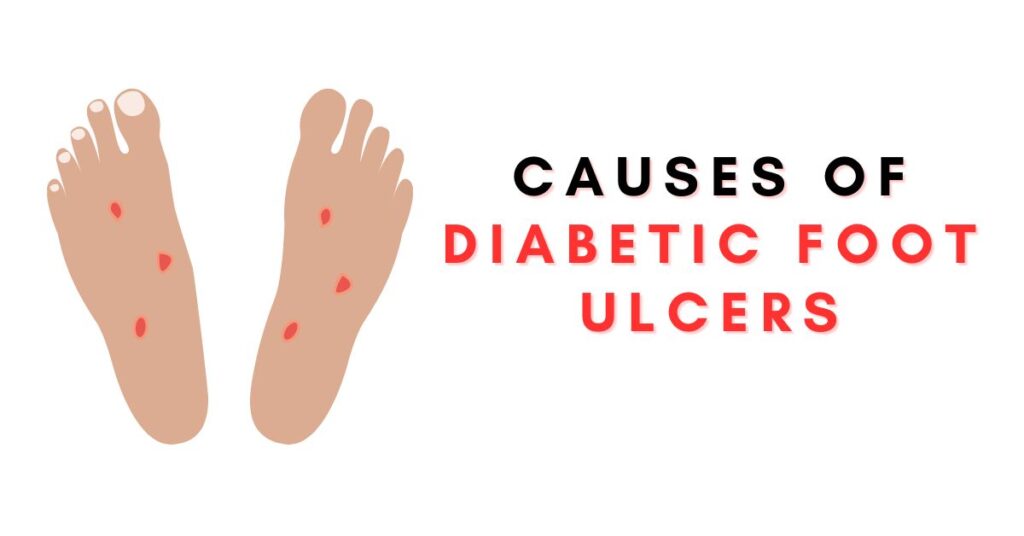
Diabetes and Its Impact on the Feet:
Diabetes is a metabolic disorder characterized by elevated blood sugar levels over a prolonged period. High blood sugar levels can lead to various complications throughout the body, including the feet. Over time, diabetes can cause damage to the nerves (neuropathy) and blood vessels (peripheral artery disease) in the feet, making them more susceptible to injury and slow healing.
Neuropathy: Nerve Damage in Diabetics:
Neuropathy is a common complication of diabetes, affecting the nerves in the feet and legs. High blood sugar levels can damage the delicate nerve fibers, leading to reduced sensation or numbness in the feet. As a result, individuals with diabetic neuropathy may not feel pain or discomfort from minor injuries, allowing ulcers to develop and worsen without their awareness.
Peripheral Artery Disease (PAD):
Peripheral artery disease (PAD) is another vascular complication of diabetes. It involves the narrowing or blockage of arteries that supply blood to the extremities, including the feet. Reduced blood flow to the feet deprives tissues of oxygen and vital nutrients, impairing wound healing and increasing the risk of developing ulcers, especially in individuals with diabetes.
Foot Deformities and Trauma:
Foot deformities, such as bunions, hammertoes, or Charcot foot (a condition characterized by the weakening of the bones in the foot), can alter the structure of the feet, leading to pressure points and areas of increased friction. Additionally, trauma, such as cuts, blisters, or burns, can occur due to improper footwear, accidents, or repetitive stress on the feet. These deformities and traumatic injuries can predispose individuals with diabetes to develop foot ulcers if not properly managed and treated.
4. Risk factors Of Diabetic Foot Ulcers
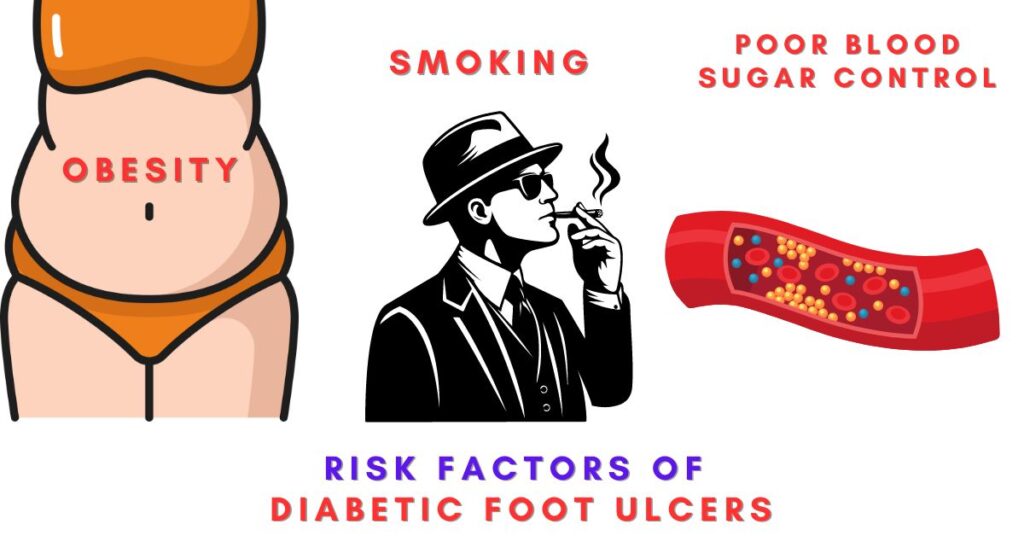
Poor Blood Sugar Control:
Maintaining stable blood sugar levels is essential for overall health, especially for individuals with diabetes. Poorly controlled blood sugar levels can damage blood vessels and nerves, leading to impaired circulation and reduced sensation in the feet. As a result, wounds and injuries may go unnoticed and heal slowly, increasing the risk of developing foot ulcers.
Smoking:
Smoking is a well-known risk factor for various health conditions, including diabetes-related complications. Smoking reduces blood flow to the extremities, including the feet, and impairs the body’s ability to fight infection and heal wounds. Individuals with diabetes who smoke are at a higher risk of developing foot ulcers and experiencing more severe complications compared to non-smokers.
Obesity:
Excess weight puts additional pressure on the feet and can exacerbate existing foot deformities or structural abnormalities. Obesity is also associated with insulin resistance and poor blood sugar control, increasing the risk of developing diabetes-related complications, including foot ulcers. Moreover, excess adipose tissue can contribute to inflammation and hinder proper wound healing.
Poor Foot Care:
Neglecting proper foot care practices can increase the risk of developing diabetic foot ulcers. This includes not inspecting the feet daily for cuts, blisters, or other injuries, wearing ill-fitting shoes that can cause friction and pressure points, and neglecting to moisturize or trim toenails properly. Poor foot hygiene and neglecting to address minor foot issues promptly can lead to the development of ulcers over time.
5. Diabetic Foot Ulcers Symptoms and Signs

Persistent Pain:
Diabetic foot ulcers can cause persistent pain, especially when pressure is applied to the affected area or during walking. The pain may vary in intensity and may be described as throbbing, burning, or sharp. Persistent pain in a specific area of the foot, especially in individuals with diabetes, should prompt further evaluation by a healthcare professional.
Redness, Swelling, and Warmth:
Inflammation is a common response to tissue injury and diabetic foot ulcers often present with redness, swelling, and warmth in the surrounding skin. These signs indicate an inflammatory response as the body attempts to heal the wound. However, in diabetic individuals, impaired circulation and compromised immune function can exacerbate inflammation and delay healing.
Drainage or Pus:
Open wounds associated with diabetic foot ulcers may produce drainage or pus, indicating an underlying infection. Pus is a sign of the body’s immune response to infection, consisting of dead white blood cells and tissue debris. The presence of drainage or pus suggests that the ulcer is infected and requires prompt medical attention to prevent further complications.
Black Tissue (Eschar) Formation:
In severe cases of diabetic foot ulcers, particularly if left untreated, dead tissue may accumulate on the surface of the wound, forming black areas known as eschar. Eschar formation is a sign of tissue necrosis and indicates that the ulcer has progressed to an advanced stage. Eschar may inhibit wound healing and increase the risk of infection and further tissue damage.
6. Complications Of Diabetic Foot Ulcers
Let’s discuss the complications associated with diabetic foot ulcers:

Infection:
Diabetic foot ulcers provide a favorable environment for bacterial growth due to the presence of high glucose levels and impaired immune function. If bacteria enter the wound, it can lead to infection. Infections in diabetic foot ulcers can spread rapidly and may become severe if not treated promptly. Common signs of infection include increased pain, swelling, redness, warmth, and drainage.
Cellulitis:
Cellulitis is a bacterial skin infection that can occur when bacteria enter the skin through a break or wound, such as a diabetic foot ulcer. It typically causes redness, swelling, warmth, and pain in the affected area. Cellulitis can spread quickly and may lead to systemic complications if left untreated. Individuals with diabetes are at a higher risk of developing cellulitis, especially in the lower extremities.
Osteomyelitis:
Osteomyelitis is a severe infection of the bone that can develop from untreated or poorly managed diabetic foot ulcers. Bacteria from the ulcer can enter the underlying bone, causing inflammation and infection. Osteomyelitis is a serious complication that can lead to bone destruction, chronic pain, and impaired mobility. Prompt diagnosis and aggressive treatment are essential to prevent long-term complications.
Gangrene:
Gangrene is the death of body tissue due to a lack of blood flow or severe infection. In diabetic foot ulcers, gangrene may occur when the infection spreads and causes tissue necrosis. It typically manifests as blackened, dry, or moist tissue in the affected area. Gangrene is a medical emergency and requires immediate intervention, as it can lead to tissue loss and the need for amputation to prevent further complications.
In summary, diabetic foot ulcers can lead to various complications, including infection, cellulitis, osteomyelitis, and gangrene. Early detection, prompt treatment, and proper wound care are essential for preventing and managing these complications and preserving foot health in individuals with diabetes.
7. Diagnosis of Diabetic Foot Ulcers
Let’s explore the diagnosis of diabetic foot ulcers:

Physical Examination:
A comprehensive physical examination is crucial for diagnosing diabetic foot ulcers. Healthcare professionals will carefully inspect the feet, looking for signs of ulcers, such as open wounds, redness, swelling, or drainage. They will also assess the surrounding skin for any signs of infection or inflammation. Additionally, the healthcare provider may check for neuropathy (nerve damage) by evaluating sensation in the feet using a monofilament or tuning fork.
Imaging Tests:
Imaging tests may be ordered to assess the extent of tissue damage and evaluate for any underlying complications associated with diabetic foot ulcers. Common imaging modalities include X-rays, which can help identify bone abnormalities, such as fractures or osteomyelitis (bone infection). Other imaging tests, such as magnetic resonance imaging (MRI) or computed tomography (CT) scans, may be used to visualize soft tissue structures and assess for deep tissue involvement or abscess formation.
Laboratory Tests:
Laboratory tests are essential for diagnosing and managing diabetic foot ulcers, especially if there are signs of infection. Blood tests may be performed to assess for elevated white blood cell count (indicating infection), elevated C-reactive protein levels (a marker of inflammation), and impaired kidney function (common in individuals with diabetes). Additionally, wound cultures may be obtained by swabbing the ulcer to identify the specific bacteria causing the infection and determine the most effective antibiotic treatment.
In summary, the diagnosis of diabetic foot ulcers involves a combination of physical examination, imaging tests, and laboratory tests. Early detection and accurate diagnosis are crucial for initiating appropriate treatment and preventing complications associated with diabetic foot ulcers.
8. Prevention Strategies
Let’s discuss some effective prevention strategies for diabetic foot ulcers:
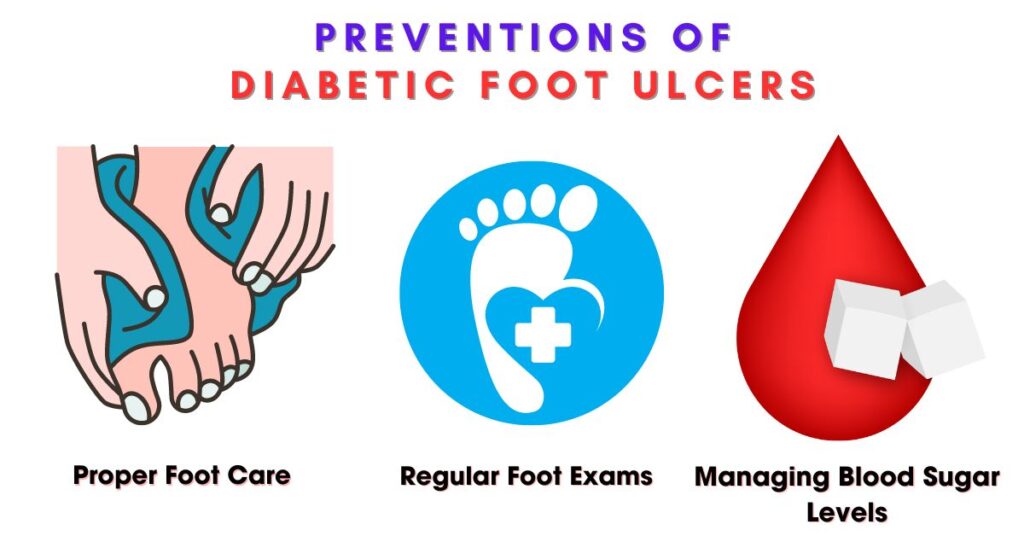
Proper Foot Care:
Proper foot care is essential for preventing diabetic foot ulcers. This includes daily inspection of the feet for any cuts, blisters, or signs of irritation. Wash the feet with mild soap and lukewarm water, and gently pat them dry, paying special attention to areas between the toes. Moisturize the feet with a gentle lotion to prevent dry skin and cracking. Additionally, trim toenails straight across and file any sharp edges to prevent ingrown toenails.
Regular Foot Exams:
Regular foot exams by a healthcare professional are crucial for the early detection of any foot abnormalities or signs of ulcer formation. Individuals with diabetes should schedule regular appointments with a podiatrist or foot specialist to monitor foot health and address any concerns promptly. During foot exams, the healthcare provider will assess sensation, circulation, and overall foot health, identifying any potential risk factors for developing foot ulcers.
Managing Blood Sugar Levels:
Maintaining stable blood sugar levels is paramount for preventing complications associated with diabetes, including foot ulcers. Monitor blood sugar levels regularly and follow a diabetes management plan prescribed by a healthcare provider. This may include taking medications as prescribed, following a balanced diet, exercising regularly, and monitoring blood sugar levels closely. By keeping blood sugar levels within the target range, individuals can reduce the risk of nerve damage, poor circulation, and impaired wound healing associated with diabetes.
Lifestyle Modifications:
Making healthy lifestyle choices can significantly reduce the risk of developing diabetic foot ulcers. Quit smoking, as smoking impairs circulation and increases the risk of developing foot complications. Maintain a healthy weight through a balanced diet and regular exercise, as excess weight puts additional pressure on the feet and increases the risk of developing foot deformities. Choose supportive, well-fitting footwear that provides adequate cushioning and support to reduce the risk of developing pressure points and friction injuries on the feet.
In summary, prevention strategies for diabetic foot ulcers include proper foot care, regular foot exams, managing blood sugar levels, and making healthy lifestyle modifications. By incorporating these strategies into daily routines, individuals with diabetes can significantly reduce the risk of developing foot ulcers and maintain optimal foot health.
9. Treatment Options
Let’s explore the treatment options available for diabetic foot ulcers:
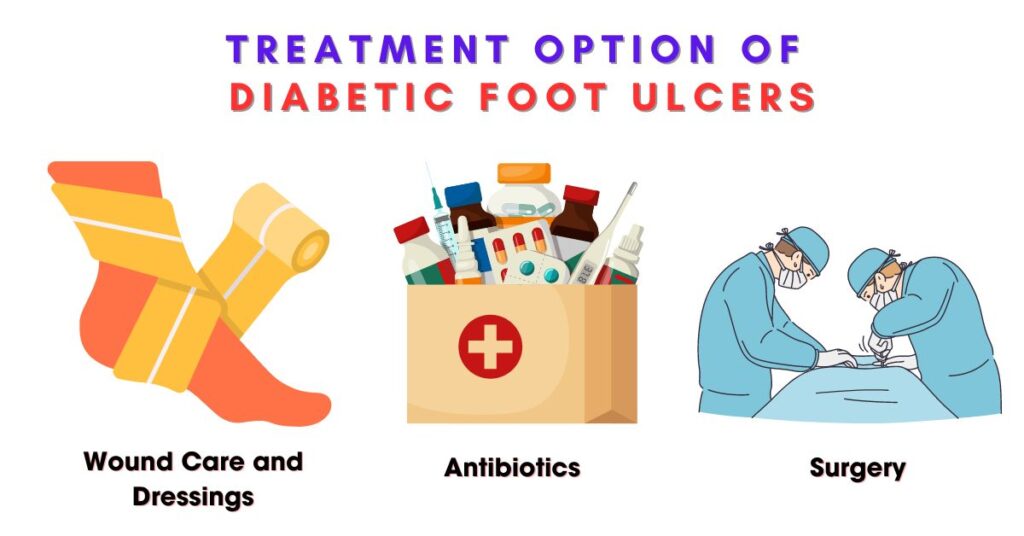
Wound Care and Dressings:
Proper wound care is essential for promoting healing and preventing infection in diabetic foot ulcers. This involves cleaning the ulcer with mild soap and water, gently removing any dead or infected tissue, and applying an appropriate dressing to protect the wound and absorb excess drainage. Advanced dressings, such as hydrocolloid or foam dressings, may be used to promote moisture balance and facilitate healing. In some cases, negative pressure wound therapy (NPWT) may be employed to promote tissue granulation and wound closure.
Offloading Pressure:
Offloading pressure from the affected area is crucial for relieving pressure on the ulcer and promoting healing. This may involve using specialized footwear, such as diabetic shoes or custom-made orthotic devices, to redistribute pressure away from the ulcer site. In more severe cases, total contact casts or removable cast walkers may be used to offload pressure and protect the ulcer during walking or weight-bearing activities.
Antibiotics:
Antibiotics may be prescribed to treat or prevent infection in diabetic foot ulcers, especially if there are signs of cellulitis or systemic infection. The choice of antibiotic depends on the type and severity of the infection, as well as any underlying risk factors, such as antibiotic resistance or allergies. Topical antibiotics may be used for superficial infections, while oral or intravenous antibiotics may be necessary for more severe or deep-seated infections.
Surgery:
In some cases, surgical intervention may be necessary to promote healing and prevent complications in diabetic foot ulcers. Surgical options may include debridement (removal of dead or infected tissue), drainage of abscesses or infected fluid collections, or correction of underlying foot deformities. In severe cases of infection or tissue necrosis, amputation may be necessary to remove the affected tissue and prevent the spread of infection to other parts of the body.
In summary, treatment options for diabetic foot ulcers focus on wound care and dressings, offloading pressure, antibiotics, and, in severe cases, surgical intervention. A multidisciplinary approach involving healthcare professionals, such as podiatrists, wound care specialists, infectious disease specialists, and surgeons, is essential for optimizing treatment outcomes and preventing complications in individuals with diabetic foot ulcers.
10. Living With Diabetic Foot Ulcers
Living with diabetic foot ulcers can present challenges, but there are ways to manage and cope with the condition effectively:

Importance of Compliance:
Compliance with treatment recommendations and self-care practices is crucial for managing diabetic foot ulcers and preventing complications. This includes following the prescribed wound care regimen, taking medications as directed, and adhering to lifestyle modifications, such as maintaining stable blood sugar levels and wearing appropriate footwear. Consistent compliance with these measures can promote healing, reduce the risk of infection, and improve overall foot health.
Psychological Impact:
Dealing with diabetic foot ulcers can take a toll on mental and emotional well-being. Individuals may experience feelings of frustration, anxiety, or depression due to the challenges of living with a chronic condition and the impact it has on daily life. Coping with pain, limitations in mobility, and concerns about wound healing can also contribute to psychological distress. Seeking support from healthcare professionals, loved ones, or support groups can help individuals cope with the psychological impact of diabetic foot ulcers and develop effective coping strategies.
Support Networks:
Building a strong support network is essential for individuals living with diabetic foot ulcers. This network may include healthcare providers, such as podiatrists, wound care specialists, and diabetes educators, who can provide guidance, support, and medical expertise. Additionally, family members, friends, or peers who have experience with diabetic foot ulcers can offer empathy, encouragement, and practical assistance. Joining support groups or online communities dedicated to diabetes management and foot health can also provide valuable resources, information, and emotional support.
In summary, living with diabetic foot ulcers requires a proactive approach to self-care, including compliance with treatment recommendations, addressing the psychological impact of the condition, and building a strong support network. By taking proactive steps to manage the condition and seeking support from healthcare professionals and loved ones, individuals with diabetic foot ulcers can improve their quality of life and optimize their long-term health outcomes.
11. Future Outlook
Looking ahead, the future outlook for diabetic foot ulcers is promising, with ongoing advancements in treatment and increased emphasis on research and awareness:

Advancements in Treatment:
Researchers and healthcare professionals are continuously exploring new treatment modalities and technologies to improve outcomes for individuals with diabetic foot ulcers. This includes the development of advanced wound care products, such as growth factors, bioengineered skin substitutes, and regenerative therapies, which promote tissue regeneration and accelerate wound healing. Additionally, innovative surgical techniques, such as minimally invasive procedures and tissue grafting, are being explored to address complex ulcers and promote optimal outcomes. As these advancements continue to evolve, individuals with diabetic foot ulcers can expect access to more effective and personalized treatment options tailored to their specific needs.
Importance of Research and Awareness:
Research plays a critical role in advancing our understanding of diabetic foot ulcers and identifying new strategies for prevention, diagnosis, and treatment. By investing in research initiatives, healthcare organizations, academic institutions, and government agencies can contribute to the development of evidence-based guidelines and best practices for managing diabetic foot ulcers. Moreover, raising awareness about the risks and complications of diabetic foot ulcers among healthcare professionals, individuals with diabetes, and the general public is essential for early detection, timely intervention, and improved outcomes. Increased awareness can also help reduce the stigma surrounding foot complications in diabetes and promote proactive foot care practices, ultimately reducing the burden of diabetic foot ulcers on individuals and healthcare systems.
In summary, the future outlook for diabetic foot ulcers is characterized by ongoing advancements in treatment and a growing emphasis on research and awareness. By leveraging innovative therapies, fostering collaboration among stakeholders, and promoting education and advocacy efforts, we can work towards reducing the prevalence and impact of diabetic foot ulcers and improving the quality of life for individuals affected by this condition.
12. Diabetic Foot Ulcers ICD 10?
The ICD-10 code E11.621 specifically denotes diabetic foot ulcers.
This alphanumeric code is used for medical documentation and billing purposes to classify and identify diagnoses related to diabetes and its complications, such as foot ulcers. When a healthcare provider diagnoses a patient with a diabetic foot ulcer, they would use this specific code to indicate the condition in the patient’s medical records and insurance claims.
13. Conclusion
In conclusion, managing diabetic foot ulcers requires a comprehensive approach that emphasizes early detection, proactive treatment, and ongoing support. By summarizing key points, we can underscore the importance of:

Early Intervention: Prompt recognition and treatment of diabetic foot ulcers are crucial for preventing complications and promoting optimal outcomes. Regular foot exams, proper wound care, and adherence to treatment recommendations are essential for minimizing the risk of infection, reducing healing time, and preserving foot function.
Comprehensive Care: Addressing diabetic foot ulcers requires a multidisciplinary approach involving healthcare professionals, individuals with diabetes, and support networks. By integrating wound care, offloading pressure, antibiotics, and, if necessary, surgical intervention, we can optimize treatment outcomes and improve the quality of life for individuals living with diabetic foot ulcers.
Lifestyle Modifications: Making healthy lifestyle choices, such as maintaining stable blood sugar levels, quitting smoking, and wearing appropriate footwear, can significantly reduce the risk of developing diabetic foot ulcers and improve overall foot health. By prioritizing self-care practices and adopting a proactive mindset, individuals can take control of their health and minimize the impact of diabetes-related complications.
In conclusion, by emphasizing the importance of early intervention, comprehensive care, and lifestyle modifications, we can empower individuals with diabetes to effectively manage diabetic foot ulcers and achieve optimal health outcomes. Together, through continued research, education, and advocacy efforts, we can work towards reducing the prevalence and burden of diabetic foot ulcers and improving the well-being of individuals affected by this condition.
14. Frequently Asked Questions (FAQs)
Can diabetic foot ulcers be prevented?
Yes, diabetic foot ulcers can be prevented through proper foot care, regular foot exams, and managing blood sugar levels.
How often should I check my feet if I have diabetes?
It’s recommended to check your feet daily for any signs of cuts, blisters, or redness if you have diabetes.
Are all diabetic foot ulcers painful?
Not all diabetic foot ulcers are painful, especially if there is nerve damage (neuropathy) present.
What should I do if I notice signs of a foot ulcer?
If you notice signs of a foot ulcer, such as redness, swelling, or drainage, seek medical attention promptly to prevent complications.
Can I still exercise with a diabetic foot ulcer?
Depending on the severity of the ulcer, your healthcare provider may recommend modifying your exercise routine to avoid putting pressure on the affected foot. Always consult with your healthcare provider before engaging in physical activity with a diabetic foot ulcer.


